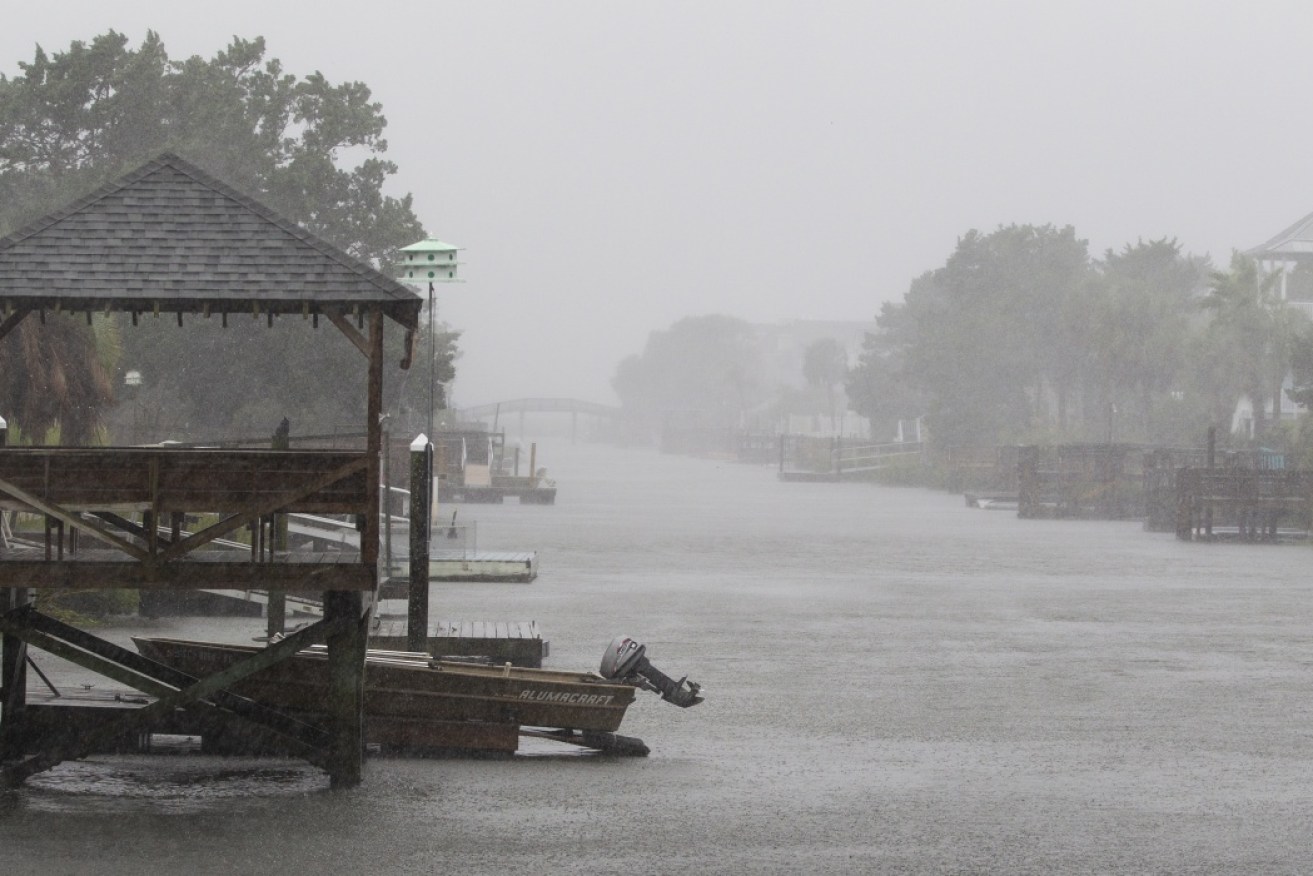Hurricane Florence and Typhoon Mangkhut leave a trail of destruction and death


Rising floodwaters from Hurricane Florence in the canals on the evacuated Pawleys Island forced hundreds of residents to flee. Photo: Getty
The sheer scale of Hurricane Florence, which has lumbered across the southeast coast of the US and dumped huge volumes of water, could leave up to 10 million Americans affected.
With the death toll having risen to five over the past 48 hours, more casualties are feared as rescuers reach remote coastal areas.
Authorities are calculating damage in terms of both human life and billion-dollar property damage inflicted by howling winds and flooding
Meanwhile, across the Pacific in the Philippines, Typhoon Mangkhut, the most powerful storm to hit the country in the past five years, is set to impact more than 5.2 million Filipinos after making landfall on Saturday with wind gusts of up to 305km/h.
Emergency services in North Carolina have reported five people have died as the 508kilometer-wide storm worked its way slowly inland, knocking down trees, gorging rivers, and dumping sheets of rain before being downgraded to a tropical storm.
It can still wreak havoc in the coming days and could leave large parts of the Carolinas under water.
The now-classified category-1 storm (it had been a category 3 on the Saffir-Simpson scale on Thursday local time), the most fierce in 30 years, has already taken the lives of a young Wilmington mother and her newborn baby. Local firefighters were seen kneeling down to pay their respects to those killed as the father was taken to a local hospital with unknown injuries.
Wilmington Fire Department 🙏…Heroes! pic.twitter.com/QRDGvcHF6y
— Lisa Jaworowski (@ljabbo) September 14, 2018
In the state’s Pender County, a woman died of a heart attack, a 78-year-old man was electrocuted attempting to connect extension cords while another man perished when he was blown down by high winds while checking on his hunting dogs.
In New Bern, North Carolina, the storm surge overwhelmed the town of 30,000, located at the confluence of the Neuse and Trent rivers.
The National Hurricane Centre downgraded it to a tropical storm on Friday afternoon, but warned it would dump as much as 75 to 100mm of rain on the southeastern coast of North Carolina and into the northeastern coast of South Carolina in spots.
North Carolina utilities have estimated that as many as 2.5 million state residents could be left without power, the state’s Department of Public Safety said. More than 22,600 people were housed in 150 shelters statewide, including schools, churches and Wake Forest University’s basketball arena.

Emergency services across the Carolinas rescue 100s trapped by rising floodwaters. Photo: AAP
Officials in New Bern, which dates to the early 18th century, said over 100 people were rescued from floods and the downtown was under water by Friday afternoon. Calls for help multiplied as the wind picked up and the tide rolled in.
The White House said on Friday that President Donald Trump had spoken with state and local officials, assuring them the federal government was prepared to help.
“To the incredible citizens of North Carolina, South Carolina and the entire East Coast … We have already begun mobilising our assets to respond accordingly, and we are here for you!,” Mr Trump said, announcing a planned visit next week.
The storm was expected to move across parts of southeastern North Carolina and eastern South Carolina on Sunday (Saturday local time), then head north over the western Carolinas and central Appalachian Mountains early next week, the NHC said.
Alert level 4 in the Philippines
On the other siode of the world category 5 Typhoon Mangkhut made landfall in Baggao in the north-eastern most tip of the country on Saturday, according to state weather agency PAGASA.
The storm has slowed down slightly and is moving westward to Ilocos Norte province, on its way to southern China, at 30km/h.
At 12:00 NN today, the eye of Typhoon "#OmponghPH " was located based on all available data at 65 km West of Laoag City, Ilocos Norte (18.3°N 120°E) pic.twitter.com/ofPoiyeyQT
— PAGASA-DOST (@dost_pagasa) September 15, 2018
According to PAGASA’s latest forecast, the typhoon, which is locally known as Ompong, will remain in the country’s area of responsibility until Saturday night.
Alert level 4 has been declared in four provinces of the northern half of the island of Luzon, where winds between 171-220kmh have been recorded.
In Cagayan and Isabela, located on the northeastern coast of Luzon, where the storm entered, the alert level has already been lowered from 4 to 3 after the passage of Mangkhut, which left strong winds, torrential rains, floods and waves of up to six metres.
The eye of the hurricane passed over those regions, two of the main producers of rice and maize, with wind gusts of 330km/h.

The typhoon is expected to remain as an intense storm cell until Saturday night.
Over 13,000 people in all regions expected to be struck by the typhoon were preventively evacuated on Friday although over 5.2 million Filipinos living in a 125km radius from Mangkhut’s trajectory will feel its impact.
Philippine authorities warned that Mangkhut’s devastating impact may be similar to that of Haiyan, a supertyphoon, which led to over 7000 deaths and disappearances and affected 16 million in November 2013.
The area through which Mangkhut will pass is less densely populated and protected by mountains, which may cushion the impact of the typhoon and result in a lower number of victims.
-with agencies








